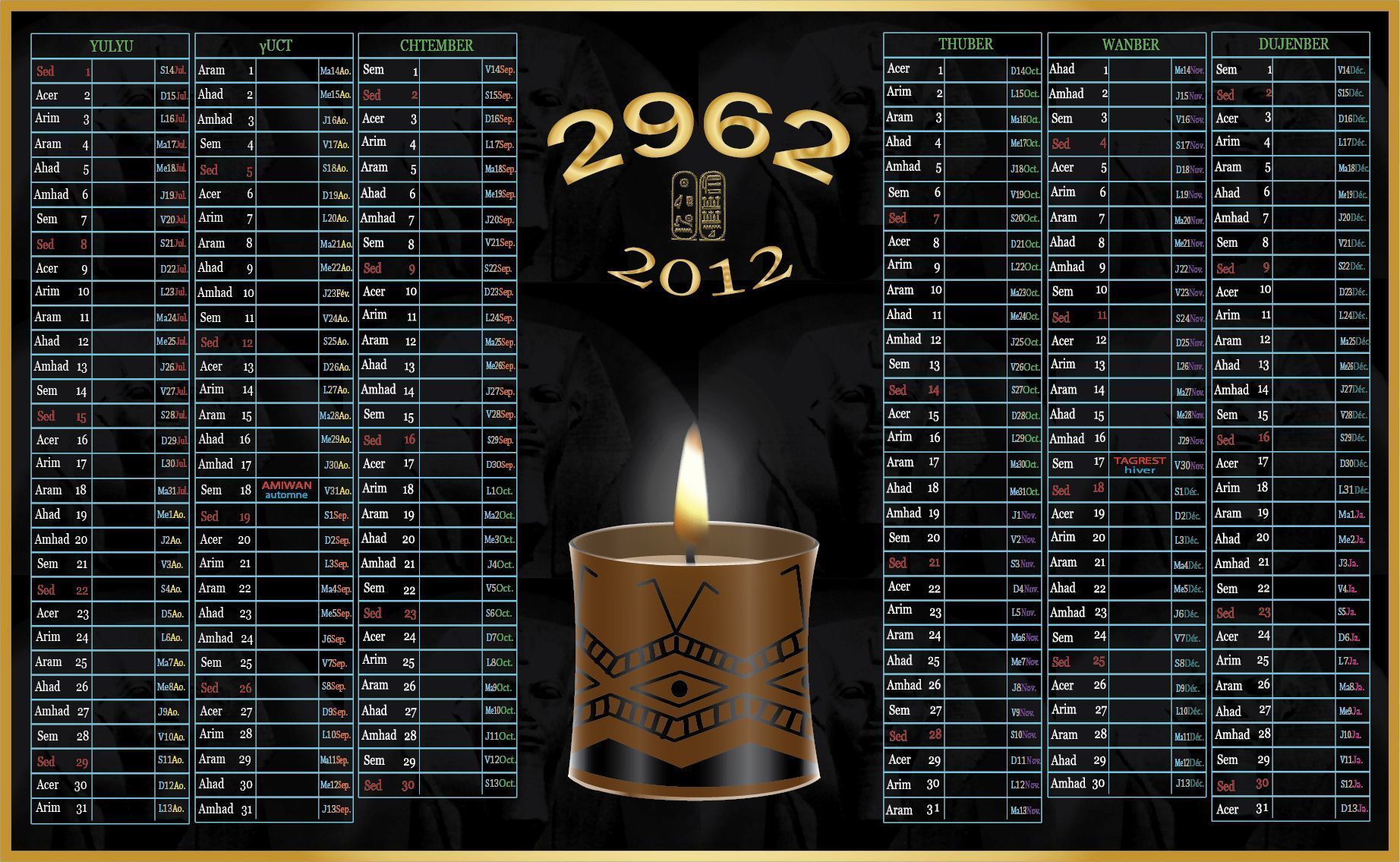Berber Calendar
Berber Calendar - Based purely on counting days, the long count more closely. It was brought back to life in the second half of the 20th century by activists who set year zero as the estimated ascension of berber ruler shoshenq i to the throne of egypt in 950 bc. Web on january 12th (or 14th, depending on the region), berber communities across the country usher in the new year with yennayer, a tradition rooted in ancient agricultural cycles and berber identity. He chose 943 bc, the year in which the meshwesh Taswast tamaziɣt) is the agricultural calendar traditionally used by berbers (amazigh, plural imazighen). It is employed to regulate the seasonal agricultural work. Web learn about the numeral systems, calendars, and social organization of the ancient berbers, a culture that developed in northwest africa for over 10,000 years. Web in the list below, specific calendars are given, listed by calendar type (solar, lunisolar or lunar), time of introduction (if known), and the context of use and cultural or historical grouping (if applicable). The calendar is utilized to regulate the seasonal agricultural works. ينّاير) is the first month of the berber calendar.
Web berber ist eine sammelbezeichnung für die indigenen ethnien der nordafrikanischen länder algerien, libyen, mauretanien, marokko und tunesien, die sich sprachlich und kulturell mehr oder weniger von den arabisierten mehrheitsgesellschaften unterscheiden. Sie führen das erbe der vorislamischen völkergruppen nordafrikas fort. Er wurde sehr wahrscheinlich während der römischen präsenz in der römischen provinz africa eingeführt, blieb aber nach dem abzug der römer und auch nach der der arabischen expansion in gebrauch, sowohl für. The first day of yennayer corresponds to the first day of january in the julian calendar, which is shifted thirteen days compared to the gregorian calendar, thus falling on 12 january every year. The berber calendar dates from the. He chose 943 bc, the year in which the meshwesh Taswast tamaziɣt) is the agricultural calendar traditionally used by berbers (amazigh, plural imazighen). Web in the list below, specific calendars are given, listed by calendar type (solar, lunisolar or lunar), time of introduction (if known), and the context of use and cultural or historical grouping (if applicable). Compare the canarian and continental sources and the influence of. It is also known in maghrebi arabic as the fellaḥi ( ﻓﻼّﺣﻲ rustic or ﻋﺠﻤﻲɛajami foreign calendar).
It was brought back to life in the second half of the 20th century by activists who set year zero as the estimated ascension of berber ruler shoshenq i to the throne of egypt in 950 bc. This calendar is also known in arabic under the name of فلاحي fellāḥī agricultural or عجمي ajamī not arabic. It is also known in maghrebi arabic as the fellaḥi ( ﻓﻼّﺣﻲ rustic or ﻋﺠﻤﻲɛajami foreign calendar). The first day of yennayer corresponds to the first day of january in the julian calendar, which is shifted thirteen days compared to the gregorian calendar, thus falling on 12 january every year. Web the berber calendar (berber languages: Web all of the mayan calendars are based on serial counting of days without means for synchronising the calendar to the sun or moon, although the long count and haab calendars contain cycles of 360 and 365 days, respectively, which are roughly comparable to the solar year. Based purely on counting days, the long count more closely. Web on january 12th (or 14th, depending on the region), berber communities across the country usher in the new year with yennayer, a tradition rooted in ancient agricultural cycles and berber identity. Die berber benutzten traditionell einen eigenen kalender, der auf dem julianischen kalender basiert. Sie führen das erbe der vorislamischen völkergruppen nordafrikas fort.
Numidya Yennayer 2964 Berber Amazigh Calendar Asseggas Ameggaz
ينّاير) is the first month of the berber calendar. ينّاير) is the first month of the berber calendar. It was brought back to life in the second half of the 20th century by activists who set year zero as the estimated ascension of berber ruler shoshenq i to the throne of egypt in 950 bc. Web the berber calendar is.
The Berbers Calendrier Amazigh 2968 / 2018 (Calendrier Berbère 2968)
ينّاير) is the first month of the berber calendar. Web learn about the numeral systems, calendars, and social organization of the ancient berbers, a culture that developed in northwest africa for over 10,000 years. Based purely on counting days, the long count more closely. This calendar is also known in arabic under the name of فلاحي fellāḥī agricultural or عجمي.
Berber Calendar PDF Ramadan
This calendar is also known in arabic under the name of فلاحي fellāḥī agricultural or عجمي ajamī not arabic. The berber calendar dates from the. On 1 may 1994, mohamed hrach erass, mbarek tausse, ahmed kikche, ali aken, said jaafer, omar darouiche and omar ochna were arrested in er rachidia after participating in. He chose 943 bc, the year in.
Calendrier berbère 2962, face 2.
Web on january 12th (or 14th, depending on the region), berber communities across the country usher in the new year with yennayer, a tradition rooted in ancient agricultural cycles and berber identity. Compare the canarian and continental sources and the influence of. Taswast tamaziɣt) is the agricultural calendar traditionally used by berbers (amazigh, plural imazighen). Web in the list below,.
The Berbers
Web the berber calendar (berber languages: Web four members from the new association for culture and popular arts, in agadir, were put in prison because they published a calendar in the berber language. Web all of the mayan calendars are based on serial counting of days without means for synchronising the calendar to the sun or moon, although the long.
30+ Berber Calendar Stock Photos, Pictures & RoyaltyFree Images iStock
The berber calendar dates from the. Web the berber calendar is a calendar used most often in the region of north africa, to control seasonal agricultural works. The calendar is utilized to regulate the seasonal agricultural works. Based purely on counting days, the long count more closely. ينّاير) is the first month of the berber calendar.
People wearing traditional dresses gather to celebrate the new year
Compare the canarian and continental sources and the influence of. The berber calendar dates from the. Web berber new year is a holiday that falls annually on january 12th in algeria and celebrates the incoming year on the berber calendar—an agricultural calendar traditionally used by the amazigh ethnic group. ينّاير) is the first month of the berber calendar. Web the.
Amazigh Calendar 2024/2974 Berber souss Inspiration From Morocco
Web berber ist eine sammelbezeichnung für die indigenen ethnien der nordafrikanischen länder algerien, libyen, mauretanien, marokko und tunesien, die sich sprachlich und kulturell mehr oder weniger von den arabisierten mehrheitsgesellschaften unterscheiden. As the gregorian calendar turns another page, a different rhythm of celebration stirs in morocco. The calendar is utilized to regulate the seasonal agricultural works. Web berber new year.
Introduce a new Calendar The Berber calendar Numista
Web berber new year is a holiday that falls annually on january 12th in algeria and celebrates the incoming year on the berber calendar—an agricultural calendar traditionally used by the amazigh ethnic group. It is employed to regulate the seasonal agricultural work. Web the berber calendar is the agricultural calendar traditionally used by berbers. He chose 943 bc, the year.
Introduce a new Calendar The Berber calendar Numista
It is also known in maghrebi arabic as the fellaḥi ( ﻓﻼّﺣﻲ rustic or ﻋﺠﻤﻲɛajami foreign calendar). Web berber new year is a holiday that falls annually on january 12th in algeria and celebrates the incoming year on the berber calendar—an agricultural calendar traditionally used by the amazigh ethnic group. Web all of the mayan calendars are based on serial.
The First Day Of Yennayer Corresponds To The First Day Of January In The Julian Calendar, Which Is Shifted Thirteen Days Compared To The Gregorian Calendar, Thus Falling On 12 January Every Year.
Web the berber calendar (berber languages: On 1 may 1994, mohamed hrach erass, mbarek tausse, ahmed kikche, ali aken, said jaafer, omar darouiche and omar ochna were arrested in er rachidia after participating in. The calendar is utilized to regulate the seasonal agricultural works. Web berber ist eine sammelbezeichnung für die indigenen ethnien der nordafrikanischen länder algerien, libyen, mauretanien, marokko und tunesien, die sich sprachlich und kulturell mehr oder weniger von den arabisierten mehrheitsgesellschaften unterscheiden.
It Is Employed To Regulate The Seasonal Agricultural Work.
Compare the canarian and continental sources and the influence of. Web all of the mayan calendars are based on serial counting of days without means for synchronising the calendar to the sun or moon, although the long count and haab calendars contain cycles of 360 and 365 days, respectively, which are roughly comparable to the solar year. It was brought back to life in the second half of the 20th century by activists who set year zero as the estimated ascension of berber ruler shoshenq i to the throne of egypt in 950 bc. This calendar is also known in arabic under the name of فلاحي fellāḥī agricultural or عجمي ajamī not arabic.
It Is Also Known In Maghrebi Arabic As The Fellaḥi ( ﻓﻼّﺣﻲ Rustic Or ﻋﺠﻤﻲƐajami Foreign Calendar).
Web learn about the numeral systems, calendars, and social organization of the ancient berbers, a culture that developed in northwest africa for over 10,000 years. The calendar is utilized to regulate the seasonal agricultural works. The berber calendar dates from the. He chose 943 bc, the year in which the meshwesh
Web The Berber Calendar Is The Annual Calendar Used By Berber People In North Africa.
Die berber benutzten traditionell einen eigenen kalender, der auf dem julianischen kalender basiert. ينّاير) is the first month of the berber calendar. Er wurde sehr wahrscheinlich während der römischen präsenz in der römischen provinz africa eingeführt, blieb aber nach dem abzug der römer und auch nach der der arabischen expansion in gebrauch, sowohl für. Web in the list below, specific calendars are given, listed by calendar type (solar, lunisolar or lunar), time of introduction (if known), and the context of use and cultural or historical grouping (if applicable).









